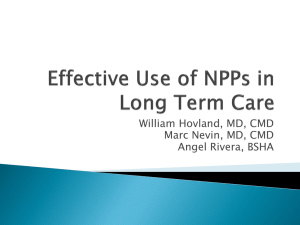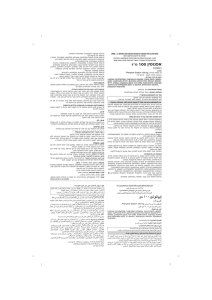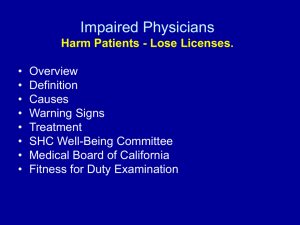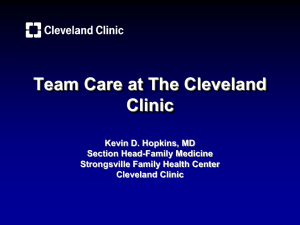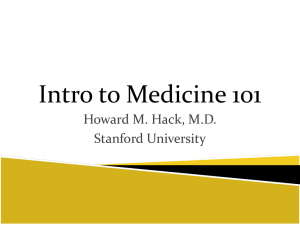Defining the Process of Medical Care to
advertisement
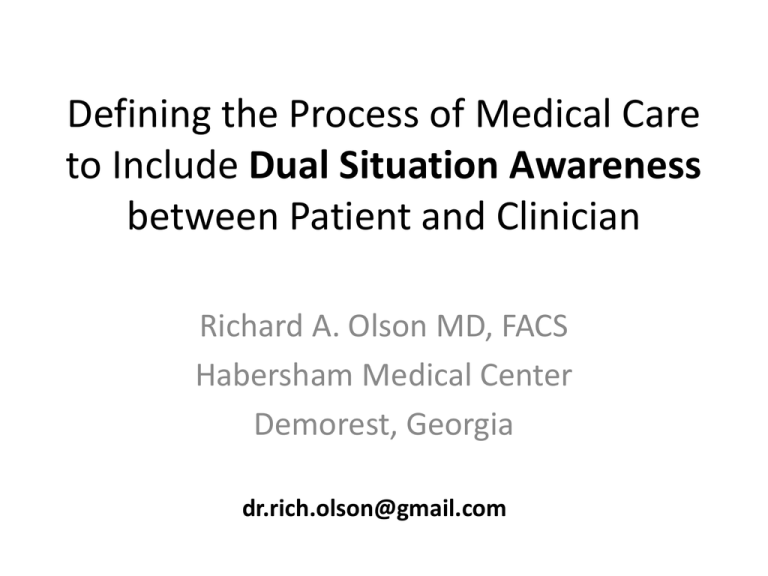
Defining the Process of Medical Care to Include Dual Situation Awareness between Patient and Clinician Richard A. Olson MD, FACS Habersham Medical Center Demorest, Georgia dr.rich.olson@gmail.com Why pursue a model of Dr/Pt SA? • Better design of Electronic Health Record – & other Health IT applications • Improve decisions – esp. shared decisions • Support “patient engagement” • Support team care delivery SOAP Note c2013 Problem Oriented Medical Record • History (Subjective) • Physical Exam, Lab Data (Objective) • Problem List – working diagnoses, not final diagnoses • SOAP Note for each Problem – Subjective – Objective – Assessment – Plan Problem Oriented Medical Record System (Weed, Hurst & Walker) Dr. Lawrence Weed, Univ. of Vermont Problem-Oriented Medical Record “The beginning clinical clerk, the new intern, and the practicing physician are confronted with an apparent contradiction. Each is asked, as a ‘whole’ physician, to accept the obligations of meeting many problems simultaneously and yet to give to each the singleminded attention that is fundamental to developing and mobilizing his or her enthusiasm and skill, for these two virtues do not arise except where an organized concentration upon a particular subject is possible.” The multiplicity of problems the physician must deal with every day constitutes a principal distinguishing feature between a physician’s activities and those of many other scientists. These realizations led me to develop the POMR so that medical students and practitioners could function in a structured, rigorous way more like that of workers in the scientific community. The POMR cannot change the multiplicity of problems that physicians face. But the POMR enables a highly organized approach to that complexity. Medical Informatics • Analysis / Communication / Record / Library Dr. Eta Berner’s skeptical student • Did we start at the right place? • If our starting point was the medical record, and not the patient-physician relationship, have we picked the best path to apply technology to improve clinical care? Situation Awareness (SA) Before making a choice to act, what do we understand about the state of mind – the perceptive and the cognitive processes which precedes that action? What WERE you thinking??? (If SA is missing, it becomes more apparent.) SA -> Decision -> Action – (Endsley) Doctor-Patient Awareness Matrix Dual Situation Awareness The Johari Window - 1955 “Named after the first names of its inventors, Joseph Luft and Harry Ingham,” this “is one of the most useful models describing the process of human interaction” 1999 by Duen Hsi Yen http://www.noogenesis.com/game_theory/johari/johari_window.html Dr-Pt Situation Awareness = SOAP (1) Dual SA: Diagnosis & Dialogue Levels of Dual SA: 3) Projection 2) Comprehension 1) Perception Communication George Bernard Shaw (1856-1950) "The single biggest problem in communication is the illusion that is has taken place" Places the burden on the physician, to choose the best way to say something, to use visual aids, and to confirm the message is correctly received by the patient. Each problem needs separate consideration • Cognitive limits of human ‘operator’ defines one ‘panel’ of SA; – Multiple physicians / specialists per patient – Multiple problems per patient • “One problem at a time” Health Affairs – Feb. 2013 “New Era of Patient Engagement” A National Action Plan To Support Consumer Engagement Via E-Health Lygeia Ricciardi, Farzad Mostashari, Judy Murphy, Jodi G. Daniel, and Erin P. Siminerio (HHS/ ONCHIT) (2) Decision Who Shall Decide?? Physician Patient Goal: Optimal Decisions • Defined as satisfactory to both patient and physician • A good decision remains satisfactory - even in hindsight • Timely - ideal responsiveness may require patient monitoring and ‘decision triggers’ Barriers to Rational Choice (besides system complexity) • • • • • • • Fear, Mistrust Myths & Misconceptions Youth & adolescence Aging & dementia Miscommunication Psychopathology Socio-pathology – “Half of the people lie with their lips; the other half with their tears,” Nassim Nicholas Taleb (3) Action: • • • • Diagnostic Therapeutic Education (patient, physician) Management – Hospitalize, Discharge – Consult – Transfer – Follow-up Action changes the Situation Cycles the D.P.U. (doctor patient unit) Pathway of Diagnosis Initial Problem -> Working Diagnoses -> -> -> Final Diagnosis Fatigue -> Anemia -> Gastric Ulcer -> Gastric adenocarcinoma Disease Trajectory • Corbin-Strauss Model, 1991 nursing model coined the term ‘disease trajectory’ • Abdominal Aortic Aneurysm growth & rupture • Diabetes with progressive kidney failure • Cancer patients with possible recurrence LINK TO THIS COMIC: HTTP://XKCD.COM/931/ TEAM Doctoring 1994 Harrison’s Textbook of Internal Medicine "Increasingly patients are cared for by groups of physicians, clinics, hospitals, organizations." With a chief drawback being, "the loss of the concept of the physician who is primarily and continuously responsible." TEAM doctoring • Primary care (Family Practice, General Internal Medicine, OB/Gyn) - “The Medical Home” • Emergency Room • Hospitalist • Critical Care • Cardiology & other Medical Specialties • Surgery (all specialties) & Anesthesiology • Medical Imaging (Radiology) Hospital Staff TEAM • • • • • • • • • Nursing (including many nursing specialties) Pharmacy Physical Therapy Occupational Therapy, Speech Therapy Respiratory Therapy Dietary – Nutrition Case Management – Social Work Clergy Support (clerical, communication, transcription) Team SA in Healthcare Endsley, M. R., & Jones, W. M. (2001). A model of inter- and intrateam situation awareness Final Thoughts & Questions • Might Dual SA be a useful model for design of EHR & Consumer E-health Systems? • Can EHR System design support Team SA? • Is Situation Awareness a useful ‘buzzword’ in healthcare, as it is in military & aviation • Would improved Dual & Team SA lead to better decisions and better outcomes, including workplace satisfaction of providers? dr.rich.olson@gmail.com



